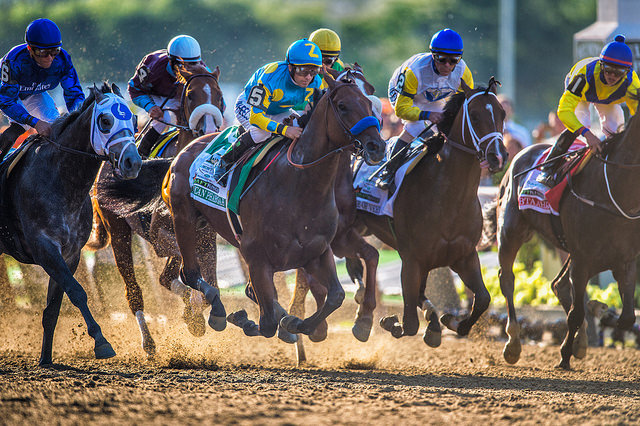Putting the American in American Pharoah?

Image: American Pharoah at the start of the race at Belmont. Source: Diana Robinson
Last year left a bad taste in the mouths of horseracing fans across the globe.
California Chrome had come off two fantastic wins in the Kentucky Derby and Preakness Stakes in order to position itself for a chance to make history by becoming the first Triple Crown winner in 36 years! The last thoroughbred to take home such an honor was Affirmed in 1978.
For those that may not follow the “sport of kings,” to win the coveted Triple Crown, a three-year-old horse must win the Kentucky Derby in Louisville on the first Saturday in May, the Preakness in Baltimore, Maryland, two weeks after that, and the Belmont Stakes in Elmont, New York, three weeks after the Preakness.
Each race is a different length. The Kentucky Derby is 1.25 miles, the Preakness is 1.1875 miles and the Belmont Stakes is 1.5 miles. Not only are the conditions and tracks of each race different, but the horse that wins has to train at a variety of different places in advance of the respective races and travel from the Midwest to the East Coast all within a matter of just a couple months.
Making matters more difficult, each race is open to new contenders that qualify, nicknamed “New Shooters,” meaning that a horse that races in the Preakness or Belmont Stakes doesn’t necessarily have to run in the Kentucky Derby. Such conditions have made winning the Triple Crown an elusive task for more than 30 years.
In the 2014 Belmont Stakes, California Chrome would only run with two other horses that competed in the previous two legs, the Kentucky Derby and the Preakness. Four entries ran in the Kentucky Derby, but skipped the Preakness that year to play spoiler, while four didn’t run in either of the previous two prestigious races for three-year-olds! Tonolist, a “New Shooter,” was well-rested and ended up winning the Belmont Stakes last year, playing the role of upset.
Controversy erupted following the race, when California Chrome owner Steve Coburn “bashed” the way the Triple Crown system was set up by allowing fresh horses to enter the last leg.
This is what made 2015 and American Pharoah’s win this weekend so special!
Maybe the writing was on the wall when the Wall Street Journal published data May 14 that indicated American Pharoah’s trip at the Kentucky Derby was one of the longest around the track, and yet, the horse still finished first. Depending on a horse’s “trip,” the length of the race is different for each.
When American Pharoah won the Preakness Stakes three weeks ago, it seemed that there was little chance that, in the longer Belmont Stakes race, another entry would be able to keep up. We already saw the data from Trackus. It was a "lock" that American Pharoah was the best horse in the longest race.
Sure enough, American Pharoah delivered, becoming the first horse in 37 years to win the coveted Triple Crown, despite the other seven horses in the 8-horse field failing to race in both the Kentucky Derby and Preakness. It was truly a sweet victory, and it was a wire-to-wire one. No other horse, fully rested as they were, had a chance. Five-and-a-half lengths separated American Pharoah from Frosted, who came in second.
Trainer Bob Baffert and jockey Victor Espinoza may now be eyeing the Breeders’ Cup Classic in Lexington in late October, perhaps to etch American Pharoah’s name in stone as the best horse in history. American Pharoah, which was purchased by Ahmed Zayat at auction as a yearling for $300,000 when he couldn’t get the price he wanted, has now won more than $4 million for his owner and is likely valued north of $20 million at stud (some estimates are as high as $50-$100 million or more).
Such a price tag, supported by his retirement years, may be too risky for American Pharoah to keep racing into 2016 and beyond, and it’s all-too-likely the Breeders’ Cup Classic may be the last we see of this champion on the track. This just happens to be one of the modern drawbacks of the sport. Once a horse has been proven on the track, its value increases exponentially at stud, often calculated as a multiple of its expected stud fee. This multiple can be as high as 400 times!
Even if American Pharoah retires after his three-year-old season, his name fits incredibly well. No matter the odds, no matter how rested the competition, the horse will keep striving for victory. That’s about as American as it gets. Look for attendance at Churchill Downs (CHDN) to skyrocket next year as horseracing finds its way back into the hearts of Americans, where it belongs. The 2015 Kentucky Derby set a record for the event, with more than 170,000 people in attendance.